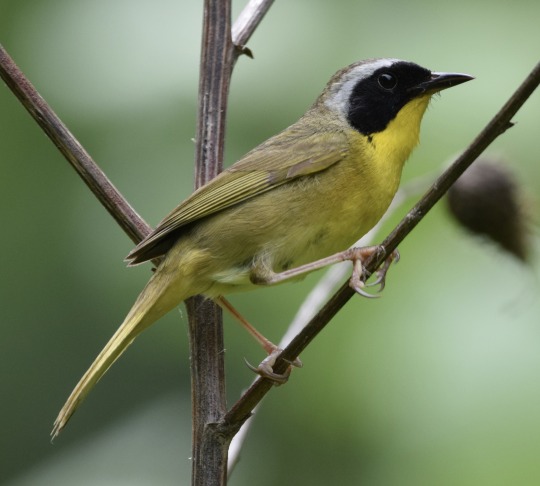#Geothlypis trichas
Explore tagged Tumblr posts
Text

Geothlypis trichas | Setophaga caerulescens | Geothlypis formosa | Setophaga citrina | Setophaga ruticilla | Seiurus aurocapilla
Plate XIV | Die Nordamerikanische Vogelwelt (1891)
#bird art#bird illustration#vintage art#vintage illustration#artists on tumblr#parulidae#new world warblers#geothlypis trichas#common yellowthroat#setophaga caerulescens#black throated blue warbler#geothlypis formosa#kentucky warbler#setophaga citrina#hooded warbler#setophaga ruticilla#american redstart#seiurus aurocapilla#ovenbird#gustav mützel
262 notes
·
View notes
Photo

Common Yellowthroat (Geothlypis trichas)
© Ryan Schain
55 notes
·
View notes
Photo

Common Yellowthroat (Geothlypis trichas)
© Brad Imhoff
26 notes
·
View notes
Text
BOTD: Common Yellowthroat

Photo: Brendan Ryan
"Abundant and well-known, the Common Yellowthroat has succeeded by being a nonconformist. As the only one of our warblers that will nest in open marshes, it is found in practically every reed-bed and patch of cattails from coast to coast. Although it sometimes hides in the marsh, its low rough callnote will reveal its presence. The male often perches atop a tall stalk to rap out his distinctive song, wichity-wichity-wichity."
- Audubon Field Guide
#birds#common yellowthroat#birds of north america#north american birds#warblers#yellowthroats#wood warblers#passerines#birds of the us#birds of canada#birds of mexico#birds of central america#birds of the caribbean#birding#birdblr#birblr#bird watching#bird of the day#Geothlypis trichas
52 notes
·
View notes
Text

Common Yellowthroat (Geothlypis trichas)
June 16, 2023
Southeastern Pennsylvania
I thought he was carrying a flower, but it turns out it is a moth.
#birds#bird#photographers on tumblr#Geothlypis trichas#common yellowthroat#birdblr#birb#birbs#ornithology#birblr#nature#animals
176 notes
·
View notes
Photo



Common Yellowthroat - Geothlypis trichas ♂
78 notes
·
View notes
Video
Portrait of a Common Yellowthroat by Georgie Alexon Via Flickr: This bird tested our patience on a sunny morning. He spent most of his time on the side of the path facing into the sun. After I almost gave up he flew to the other side of the path. Then it took time for him to pop up to a blade of marsh grass that did not have other reeds in front of him. He was busy singing for a girlfriend the whole day. The Common Yellowthroat was one of the first bird species to be catalogued from the New World, when a specimen from Maryland was described by Linnaeus in 1766. This photo was taken at Frank Lake which is south of Calgary, Alberta, Canada -Geothlypis trichas
#bird#common#yellowthroat#wildlife#nature#Geothlypis trichas#Parulidae#new world#warbler#colours#yellow#green#masked#batman#portrait#canon#eos#R3#Georgie Alexon#oiseau#outside#Canada#Calgary#countryside#morning#summer#bokey#bird photos#animal#wildlife photography
7 notes
·
View notes
Text

Common Yellowthroat
4 notes
·
View notes
Text

common yellowthroat (Geothlypis trichas) by alekivz
Window collision, held in box for approximately 45 min before safely returned to habitat
#geothlypis trichas#mariquita-de-mascarilha#common yellowthroat#animal#bird#human#hurt#shadow#upload
0 notes
Note
Central CT, today. It was in weedy area by an overflow stream. Was with a bunch of Northern Parulas. This was the only one nice enough to stay put for a few minutes, but not nice enough to give me a wing view. All the little guys in my bird books seem to either have an eyeline or an eyebrow, so guessing I'm barking up the wrong family tree.


Birb Friend ID - CT, USA:
Ok, so, hello, yess, this lookes to me like immature female Common Yellowthroat (Geothlypis trichas), family Parulidae, so you are in the right family.
Common Yellowthroat Identification, All About Birds, Cornell Lab of Ornithology
81 notes
·
View notes
Text
The common yellowthroat (Geothlypis trichas), also known as the yellow bandit or Maryland yellow-throat.
48 notes
·
View notes
Text

Common Yellowthroat Geothlypis trichas
5/4/2023 Orange County, California
#yellowthroat#common yellowthroat#warbler#warblers#wetland#north american birds#birding#bird#birds#bird photography#birblr#wildlife#wildlife photos#wildlife photography#nature#nature photos#nature photography#birdwatching#birding photos#my photos#california#california wildlife
64 notes
·
View notes
Photo

Common Yellowthroat (Geothlypis trichas)
© Marc Boisvert
62 notes
·
View notes
Photo

Common Yellowthroat (male), Geothlypis trichas
256 notes
·
View notes
Text

Common Yellowthroat (Geothlypis trichas) staring right at ya.
7 notes
·
View notes
Text
Warbler Showdown; Bracket 5.2, Poll 2


Common Yellowthroat (Geothlypis trichas)
IUCN Rating: Least Concern
Range: migratory; common indeed! One of the few birds found in all 50 States, though it's more common in the East than the West. Also found breeding in almost all Canadian Providences, save Nunavut and other polar regions. Overwinters in Southesat US, Mexico, the Caribbean, Belize, Honduras, Guatemala, and Nicaragua, scarcely into Costa Rica/Panama.
Habitat: prefers wet areas, though can be found in prairie habitats as well- the preference seems to be for dense growth and low vegetation, which are common in wet areas.
Subspecies: 13
Altamira Yellowthroat (Geothlypis flavovelata)
IUCN Rating: Near Threatened
Range: sedentary; coastal Mexico, on the Gulf side in a limited area. Central and southern Tamaulipas, east San Luis Potosí, and northern Veracruz.
Habitat: freshwater marshes with extensive reedbed vegetation, though it can also be found in pond reeds and irrigation ditches.
Subspecies: None
Image Sources: Common (Brad Imhoff); Altamira (Daniel Garza Tobon)
10 notes
·
View notes